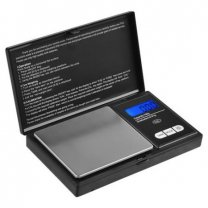Scales that weigh to the hundredth

A pocket digital scale will use a digital pressure gauge to weigh objects. Normally you need special weights to calibrate the scale, however, these weights are very expensive and can be easily lost. It is also not economical to use these weights if you only calibrate the scale once or twice a year. Instead, it is possible to calibrate your scale with things lying around the house.
Step 1 - Clean the Scale
Make sure that the pocket scale is completely clean. There are many things that can make it difficult for the scale to zero, and many times you may not even be able to see what is affecting the scale. First, wash the scale with water and then use acetone or ethanol. Allow the scale to completely dry, normally about 20 minutes.
Step 2 - Reset Scale to Zero
You want to reset the scale so that it is at zero. Do this with absolutely nothing on the scale. Once the scale is properly zeroed, you can go about calibrating it properly. If the scale is not zeroing properly then ensure that it is on a completely level surface. Sometimes if there is air flow over the scale this can also cause a problem, so choose the location of the scale carefully. It may take up for a minute for the scale to zero, so be patient.
Step 3 - Find the Calibration Weight
The calibration weight for the pocket scale will be found in the manual, and you want to find something that is close to that weight. If you do not have the manual then check under the scale as the manual can sometimes be printed on the bottom. If not, then look in a supply catalog or contact the company. Without similar weights, you cannot properly calibrate your scale, so knowing this number is crucial. Normally this weight will be a number range, such as one gram to 100 grams.
Step 4 - Find Nickels for Great Substitute Weights
Since most pocket scales will use grams for its weight measurement, nickels are a great object to use as each nickel weighs five grams. So, for example, if you need a weight of 50 grams for calibration, use 10 nickels. It is important that the nickels are also clean, otherwise it can affect your calibration weight.
Step 5 - Calibrate
Press the calibration button and place the appropriate number of nickels on the scale. Normally calibration can take some time and the digital readout will flash when calibrating. You may need to put several weights on depending on the scale. Make sure you have the appropriate amount of nickels out beforehand because if you do not immediately put on the next weight then the calibration may not work.
Step 6 - Check the Calibration
Once you have calibrated the scale, you want to check it. Turn the scale off and wait about a minute. Turn the scale on again and weigh another object of which the weight is known. Many kitchen food products will have the weight set on the container so they make a good test item. If the scale reads the correct weight or within the margin of error, also noted in the manual, then your calibration was successful.
Related posts:

 One of the more cost-effective measurements in a paper mill is that which monitors the flow of pulp stock into the head box of the paper machine. The stock level…
One of the more cost-effective measurements in a paper mill is that which monitors the flow of pulp stock into the head box of the paper machine. The stock level… Why is taking all the tricks called a boston in pinochle what are kegel exercises How to change administrator on windows 10? In what order should you learn tricks…
Why is taking all the tricks called a boston in pinochle what are kegel exercises How to change administrator on windows 10? In what order should you learn tricks… Overview Marel Marine Scales are specifically designed for use on board fishing vessels and factory trawlers. This cost-effective series of scales ranges from the…
Overview Marel Marine Scales are specifically designed for use on board fishing vessels and factory trawlers. This cost-effective series of scales ranges from the… How long to air fry french fries what does fafsa stand for What does it mean when ypu use alocohol and the tips of your fingers turn white Who raps bitches aint…
How long to air fry french fries what does fafsa stand for What does it mean when ypu use alocohol and the tips of your fingers turn white Who raps bitches aint… Globe s portion control scales can be used in a wide spectrum of applications from delis and pizza parlors, to bakeries and restaurants, or any establishment where…
Globe s portion control scales can be used in a wide spectrum of applications from delis and pizza parlors, to bakeries and restaurants, or any establishment where…